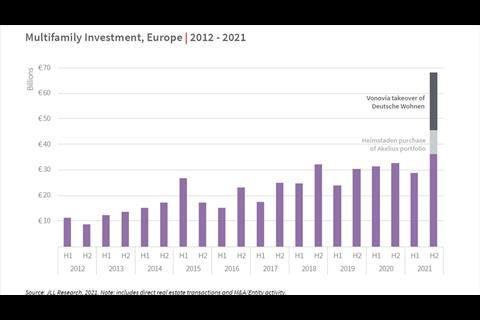How can investors access Europe's booming but supply-strapped multifamily housing sector and where are they looking to invest? JLL's EMEA Living team share their latest insights on this red hot asset class.
It is becoming a familiar refrain in sectors where existing supply is limited and investor appetite is strong: ‘If you can’t buy it, build it’.
The European multifamily sector, which saw €14.1 bn of investment in the first quarter of this year following a record €97.5 bn in 2021, is no exception.
Institutional investors seeking to access or build scale in this booming market are increasingly forging relationships with local developers – the creators of the stock – to ultimately own the final product. These partnerships can take a variety of forms, from forward funding to joint ventures and other platforms – in some cases even buying equity stakes or taking over developers wholesale as a way of securing in-house operational expertise and future product.
Research from JLL reveals that forward deals accounted for 20% of the nearly €98 bn that was invested in the European multifamily sector in 2021. While this share may appear modest, it should be seen against the backdrop of record overall investment activity – up nearly 50% on 2020 - driven by major platform deals.
Excluding the mega entity portfolio transactions that defined the market last year – notably Vonovia’s takeover of Deutsche Wohnen for around €23.5 bn and Heimstaden’s €9.1 bn purchase of the Akelius portfolio - the figure rises to 34% and reflects over €19 bn committed to building new rental homes across Europe. This is marginally up on 2020 (30%) but significantly higher than 2015 (10%), underscoring how the market has evolved over the last six years.
Gemma Kendall, head of multifamily living capital markets for EMEA at JLL, expects this trend to continue as investors become more creative in their strategies to access product. With the exception of mature markets such as Germany, Sweden and the Netherlands, the supply of existing, income-producing stock across much of Europe is limited.
‘The European multifamily market is relatively immature compared to the US. Outside of Germany and potentially the Netherlands, a significant proportion of deals is forward deals, whether that’s commitment or funding,’ she says.
Particularly against a background of compressing yields over the past years, such transactions are increasing in scale and complexity. According to JLL, forward funded projects typically have a yield spread of 25-50 bps against stabilised, income-producing assets of similar quality.
Forward deals
A snapshot of multifamily investment in the first five months of 2022 testifies to ongoing momentum in forward deal activity. Nordic giant Heimstaden, for example, continued its expansion across Europe in April by acquiring a 464-home project in Edinburgh from the developer Platform for SEK 1.5 bn (€150 mln), while in Warsaw, it purchased a 400-apartment project from the developer Dantex. Also in April, M&G Real Estate said it was forward funding a €60 mln development in The Hague in the Netherlands as part of its strategy to increase its residential exposure in Continental Europe.
Earlier in the year, the firm acquired a majority stake in UK housebuilder Greencore Construction, with plans to invest up to half a billion pounds over the next three to five years in sustainable new developments of private and affordable housing. In Ireland, Round Hill Capital and QuadReal Property Group recently upsized their multifamily JV by €200 mln. The additional capital will be used to forward fund the purchase of apartment blocks across the country and brings the investors’ total funding commitment to Irish housing to €575 mln.
This ‘marrying of equity with expertise’, including recapitalisations, is fast becoming an efficient way of building BTR portfolios. ‘Even institutional investor groups that have strong (commercial) asset management platforms have needed to partner up with residential experts,’ says Kendall.
‘There’s a relatively large amount of constant asset management that needs to be done on residential assets, so until they build that in-house expertise, they need to lean on an external party, whether that’s through a joint venture situation or by paying fees. But we’re now starting to see them bring that expertise more and more into the organisation because they realise that in doing so, they can benefit from the value creation that entails.’
From the developer’s perspective too, such tie-ups can be attractive. Notes Kendall: ‘Some developers which have historically been “build to sell” players have realised that they have quite an interesting opportunity to partner with equity and build a BTR platform with that group – increasing their exposure to land banks and operators in the process.’ In the current inflationary environment, she adds, smaller developers are likely to be hit harder by cost increases, so there is likely to be ‘some consolidation and a significant amount of movement in that space’.
New hotspots
Besides strategic partnerships, investors are also broadening their geographic horizons in their hunt for product. The current operational stock – or investible universe - is heavily concentrated in a few markets, with Germany accounting for around 50% of the total floorspace of the sector in Europe, followed by Sweden and France.
But new hotspots are emerging, and even large geographies like the UK, which has limited standing stock opportunities for buyers, are coming into focus as development pipelines swell. In the UK’s case, projects under development are set to more than triple the number of multifamily units, and this number is growing by the month as more planning applications are approved.
‘Germany has a very long – 20 years-plus - history of private companies and semi-public companies owning residential blocks. The UK doesn’t at all,’ explains Tom Colthorpe, associate in the EMEA living research & strategy team at JLL and co-author of the firm’s report series ‘Multifamily: A sector coming of age’.
‘The proportion of renters there is very low compared to Germany, France or the Netherlands and the market has traditionally been dominated by buy-to-let landlords. But in the last six years or so, institutional investors have woken up to the fact that residential and multifamily is an asset class that they can own and operate. They’ve looked to the US in particular to see how that market works.’
Whereas the rental-ownership rate in Germany is more or less evenly split, it is skewed towards ownership in the UK, with renters accounting for no more than 20%. In some big German cities like Berlin, the proportion of renters is as high as 75-85, partly because of regulation protecting tenants such as rental caps.
‘That’s why some investors are looking at the UK, particularly now that capital value growth is likely to be relatively limited for some markets,’ adds Colthorpe. ‘The UK is attractive because it offers significant growth. There is no rental cap situation, so if supply starts to come in and demand stays the same, the only thing that will change is that rents will go up.’
With the exception of the UK and Finland, most of the rest of Continental Europe has some kind of regulation in place on maximum rent hikes.
Nascent markets
Other emerging markets that have started to appear on investors’ radar include Poland, Belgium and Portugal. Structural barriers hampering the development of a professionalised rental sector in these countries are being overcome as investors find their way and plough in record amounts of equity. In Belgium, which attracted €250 mln of investment last year, much of the activity involves forward funding by major cross-border investors, says Kendall. ‘Big institutional players like Patrizia and CBRE IM already have platforms there so it is a case of adding residential on to that.’
Portugal, which historically has a strong build to sell market, is attracting interest from investors enticed by the higher yield prospects. Up to now, most of the activity has been in the student housing space, but investors are ‘having conversations with developers to unlock opportunities in the BTR sector’, says Kendall.
In Poland, which recorded €675 mln of deal volumes in 2021, investors are similarly drawn by the high-yielding growth opportunities, but with the additional advantage of scale. Observes Kendall: ‘It’s scale they can get access to here, it’s a really dynamic, fast growing market with a large youthful population and it also has one of the highest build out rates in Europe, i.e. the proportion of new apartments built every year in relation to the existing residential stock.’ The only factor holding institutional groups back, she says, are high financing costs and the potential need to hedge against currency risk (Zloty).
Secondary locations
Besides new national markets, investors are also venturing into new city and regional locations. The benefits of going beyond the mainstream core locations to secondary and tertiary towns and cities include risk-return pay-offs, higher rental growth, bigger scale through diversification and less competitive bidding.
JLL's research shows that the more mature markets of Germany, the Netherlands, Sweden, and Denmark have a deeper pool of potential locations to invest in and a lower reliance on just one gateway market. Says Kendall: ‘With compressing yields, investors always look for where they can get a slightly higher return and take on a bit more risk – so a strong university town in Germany will give you that if there’s a supply-demand imbalance.’
In nascent markets, this process is only just beginning and investor confidence in the performance of multifamily assets will first be tested in a gateway city or two, before venturing further afield.
‘As groups get more experienced around multifamily investment, with a local partner on the ground, we’ll see more going into secondary locations – so once they’ve done their first investment in say, Madrid, they might branch out to Valencia and Malaga – and from there move into Porto in Portugal,’ says Kendall. ‘If you look at its portfolio, Catella has built up a lot of assets in B and C cities because it has a good local presence in those markets. The more advanced groups are confident about not necessarily focusing on just the major cities.’
In the UK, where investment has traditionally been weighted towards London (as high as 80% in 2014), strong prospects in regional cities are shifting investor attention beyond the capital, despite the nascent BTR market. Remarks Kendall: ‘Although London remains the focus, some investors are opting to do their first deal in Manchester or Birmingham, or even a science hub location like Oxford or Cambridge or other commuter towns.’
*****
Social and affordable housing – a question of regulation?
Europe’s rent-controlled housing sector differs from market to market in terms of regulation, ownership and size, reflecting a range of cultural and political factors which have evolved over time.
JLL qualifies the UK and Finland as the ‘freest’ markets in Europe without any significant form of rent control, while mature markets such as Germany, the Netherlands, and Sweden have traditionally had schemes in place to protect residents in the form of rental caps and eviction bans. In Germany’s case, the rental housing stock is mainly held by listed groups, whereas in the Netherlands it is concentrated in the hands of large-scale domestic institutions such as pension funds, and in Sweden the biggest landlords are private housing companies.
Against the background of a deepening housing shortage, exacerbated by a cost of living and refugee crisis, some countries are now seeing calls for more social and affordable housing.
But what constitutes social housing, and what is affordable?
Germany has very little ‘pure’ social housing - around 1.1 million units nationally, compared to 22 million private rented units, according to JLL. In the UK social housing is a very distinct and heavily regulated asset class, more or less equivalent to the PRS sector in terms of number of units. France distinguishes between three categories of rent: private, intermediate (15% below private market rents) and social rents.
In the Netherlands, the government recently presented plans to expand rent controls to cover more Dutch housing, in an effort to boost the supply of affordable homes. The proposals call for the current maximum rent in the rent-controlled sector to be increased from €763 per month to between €1,000 and €1,250, in a bid to regulate mid-market rents and ‘better protect tenants and buyers’. The new system, which is slated to come into effect in 2024, would mean far more properties will fall under rent controls.
In the UK too, the mayor of London has been pushing for increased regulation on the capital’s rental market for the last few years to address a spiralling housing crisis. However, measures such as a rent freeze are unlikely to happen, especially under a Conservative national government, believes JLL’s Tom Colthorpe. ‘The legal jurisdiction on tenancy regulation in the UK lies with the national government, and the current administration has so far resisted the mayor’s requests,’ he says.
Nonetheless, political interventions and regulatory changes – as recently proposed in the Netherlands and as witnessed in Germany last year when a rent freeze introduced by the Berlin government was subsequently overturned following a national court ruling – remain a risk for investors and could cloud the outlook in some markets.
In London's case - where recent data shows the number of available rental properties has fallen by nearly 50% compared to 2019 levels - BTR housing funded by institutional landlords has an important role to play in the supply equation, says Colthorpe, and new, stringent regulation ‘could create a deterrent to investment in the near-term'.
Eri Mitsostergiou, director of European research at Savills, similarly describes a more stringent regulatory environment as ‘one of the emerging risks’ of the multifamily sector. At the same time, she says: ‘We believe that while these measures limit rental growth prospects, they provide security to tenants, thereby reducing the risk of frequent tenant turnover, and suit core investment strategies.’
At ULI Europe’s recent annual conference in Brussels, Sorcha Edwards, secretary general of Housing Europe, called for a ‘reset’ on housing policy in Europe. ‘In many cases, policy makers are playing catch-up to solve the housing crisis. We really do need to reset and get the policies up to date to handle the situation,’ she said.
‘We’re seeing a real mismatch between people’s incomes and what they’re actually having to pay on rent,’ Edwards noted, pointing to Lisbon as an example, where she said an average two-bedroom flat costs more than 100% of the average salary. ‘And Lisbon is not alone. There are very few capital cities where the average is less than 30% of people’s income and in many cases it’s going over 60%.’












